The COVID-19 pandemic has affected all industries, including the building and construction industries. Now that businesses are slowly starting to resume operations, the top priority in everyone’s mind is safety.
The safety of every worker on the site has been and should always be the priority in every construction site. According to OSHA, nearly 6.5 million work in the construction industry, where the fatal injury rate is higher compared with other industries.
A construction site presents so many hazards that can fill the schedule of a personal injury attorney. The most common potential hazards in a construction site are the following:
- Falls
- Scaffold collapse
- Electric shock
- Head injuries, due to failure to use PPE
Site managers and safety officers have to ensure that safety measures are in place to keep the workers protected from potential hazards. Each worker must be in full Personal Protective Equipment (PPE). Full PPE means having the correct gear for the following:
- Eye and face protection
- Hand protection
- Head
- Electrical safety
They should also be in the proper gear when working with scaffolding, elevated surfaces, cranes, and forklifts.
Keeping Workers Safe Against a Virus
The COVID-19 pandemic has given construction site managers another hazard to contend with. Employers have the responsibility to ensure the health and safety of their workers. When your workers are assured that you are taking the necessary steps to ensure their safety, they are more likely to report for work. It will promote the worker’s confidence and trust that they are in safe hands.
As always, it is important to be alert to the conditions in your locality. How does the local community deal with the virus? Is the number of positive cases on the rise, or is it under control? How is the availability of testing kits? Through this information, you may be guided on how to implement your site’s safety protocols and measures.
Assessment and evaluation of the hazards that your workers will be exposed to is important for you to take preventive actions.
You can follow the exposure risk levels defined by OSHA, which are:
- Lower Risk of Exposure: These are tasks that allow your workers to work at least 6 feet from each other, with little to no contact with visitors and customers.
- Medium Risk of Exposure: These include tasks where your workers need to work within 6 feet with each other, as well as with visitors and customers.
- High Risk of Exposure: Indoor work sites occupied by workers, residents, or customers are classified to have a high risk of exposure. This also includes sites where the occupant has signs and symptoms of the COVID-19 virus.
Protecting Your Workers Against the Virus

For tasks with a high risk of exposure, you may consider delaying the work if it is not deemed essential for the success of the project. If the work is essential, make sure to set up physical barriers between workers. Have your employees adhere to the CDC’s recommendation of wearing face masks and frequent handwashing. Set up handwashing stations in the work area to encourage your employees to take personal hygiene seriously.
Follow CDC’s protocols on how to reduce your employees’ risks of exposure. Check your employees for COVID-19 symptoms daily. Those who are experiencing symptoms and have had close contact with a COVID-19 positive patient should be isolated and tested immediately. They should also undergo home quarantine and should their test be positive, contact tracing must be done. Employees who are sick should stay at home for 14 days and monitor their health.
It will be helpful to have a COVID-19 response team who will be responsible for the implementation of the policies and procedures with regards to COVID-19 prevention. Being informed on how to reduce the risks of contracting the virus is essential. Here are some work policies that should be implemented:
- No handshaking protocol
- Washing or sanitizing the hands before entering the work area
- Checking the temperature upon entry on the site
- No face mask, no entry
- No carpooling when going from site to site
Working areas should be disinfected, as well as high-touch surfaces such as doorknobs, tools, and machines. There must also be proper handling and disposal of PPE’s to ensure the safety of everyone.
Improve Work Practices
Site managers should also look into the work processes on-site to help minimize the risks associated with the job. All visitors should be screened for COVID-19 symptoms. If at all possible, limit the visitors that enter the site to those that are only essential to the project. Non-work related visits should not be allowed on the site.
Another way to ensure that safe physical social distancing protocols are observed is to adapt different working shifts. This will also limit the contact between your employees. Should one worker test positive for the virus, only one shift will be affected while the remaining shifts can continue the work.
Material deliveries into the site must also be well-coordinated and should be done when there are few people on-site. Minimize in-person meetings and opt for online meetings whenever possible.
While the pandemic should not stop your construction activities altogether, you should also ensure that your people are safe and protected. Adhering to the safety protocols of WHO, CDC, and your local government can help keep your people safe from the virus as much as possible.

